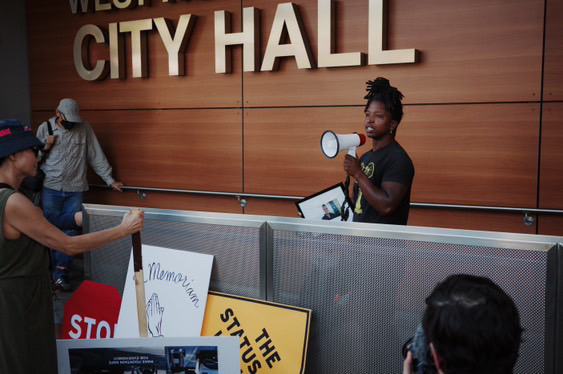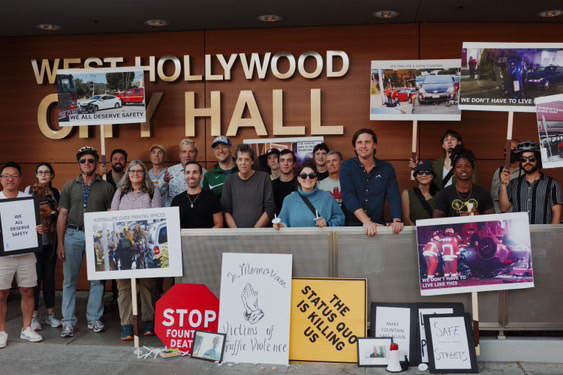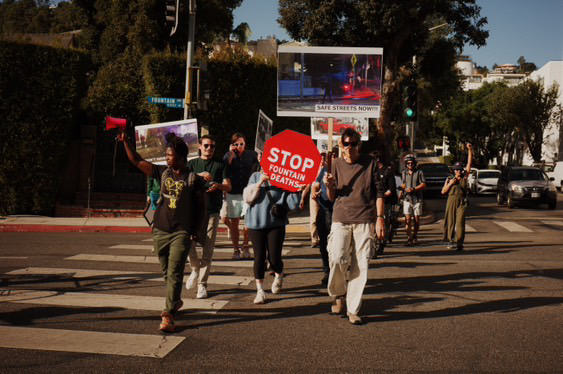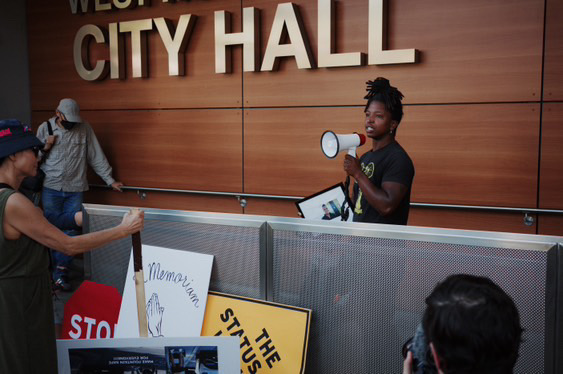

Today we’d like to introduce you to Jesi Harris.
Hi Jesi, please kick things off for us with an introduction to yourself and your story.
I moved to LA back in 2013 and my first job here was working at a youth homelessness shelter. Not only was I completely blown away by the sheer volume of young people struggling with housing that we saw on a daily basis – sometimes up to 200 – but also I noticed very quickly that the young people were often victims of traffic violence, sometimes to their demise. In fact, exactly a month after I started working at the youth center. A young person named Unique was standing on the sidewalk one night and was killed when an SUV jumped the sidewalk and dragged her about 30 feet in front of her friends. And it goes without saying that the friends who were standing with her, and witnessed this, they were never quite right after that. And I remember thinking, “Well, that’s really sad, but at least it’s not very common. At least it doesn’t happen often.” Boy was I wrong.
It didn’t really hit me until it happened to a young person that I was very close with – he was my intern through the Youth Center’s Employment Program which matched homeless young people with staff at the center so that they could get work experience. And one day my intern didn’t show up, which was very unlike him. He was very responsible and really excited to be working the internship. The first day I didn’t think much of it. The second day I started to grow concerned. And then on the third day that he missed work, the Director of the youth center came into my office, closed the door and told me that he had been killed by a car on his way back to the shelter one night. I kept my door closed for the rest of the day and cried in my office. And then I said “This can’t happen anymore! This shouldn’t have happened in the first place!” That was the start of my journey down this rabbit hole of urban planning – having enough housing so young people like Dewayne don’t have to live on the street and making our streets safer at the same time. After that I started working more closely with safe streets organizations (I was also hit by a car while riding my bike around this time) and advocating for safe streets – what we call mobility justice. Creating space in our roadways and our public rights-of-way for people walking and biking and taking public transit. And I started coming across these people called Urban Planners. I didn’t really know what Urban Planning was at the time, but the more I did this work, the more I learned that it kind of all sits at the crux of Urban Planning – housing and transportation and many other things, as well. And I fell down the rabbit hole and ended up getting a master’s in urban planning from USC. I graduated from that program in 2021 and since then I have been working as a Land Use Consultant, which means I represent projects – mostly housing projects, mostly mixed-income and affordable housing projects – through what’s called the “entitlement process.” That is the process through which you ask the city’s permission to build the thing that you are proposing.
Alright, so let’s dig a little deeper into the story – has it been an easy path overall and if not, what were the challenges you’ve had to overcome?
But, no, of course it hasn’t been a smooth road. Ya know, what’s interesting is that, after my intern Dewayne died and after I myself was the victim of a of a hit-and-run in our public streets, I thought, “OK, well we gotta make the streets safer. And we need to build more housing. So let’s get to work; let’s do that.” In my mind, it was a simple process – just build some housing, widen some sidewalks, put in some bike lanes, and some crosswalks. But you wouldn’t believe, in practice, how difficult it is to convince Angelenos that we need more housing, or that we need bike lanes, or that we need adequate sidewalks or improvements to public transit. So no, it has not been a smooth road. It sometimes feels like I have to personally fight every everyone, every entity, every interest in order to get housing approved. And that is, mind you, during the worst housing crisis that the world has ever seen. And, and I don’t use that phrase lightly. Los Angeles literally has the most expensive housing (in relation to median income), the least housing units (in relation to our existing and projected population), and some of the most dangerous streets in the world. I also want to emphasize that that is in the context of the world’s fourth largest economy. What is going on here?
Alright, so let’s switch gears a bit and talk business. What should we know?
At our simplest, we’re Urban Planners. We specialize in working with for-profit developers of housing projects who are willing to include affordable units in their projects, especially in the Coastal Zone where housing is really expensive. These are covenanted affordable units that are only available to people making below a certain income for a certain number of years, 55 or 99 depending on the policy. There’s a lot of state and local policies that help to encourage developers to do this. The one that we use the most is called the state Density Bonus law (which is reflected in local policy) and it basically means that if you’re a housing developer and you are including a certain percentage of affordable units that you can get a bonus on the number of overall units you’re allowed to build. So, it means that you can develop more market rate units as well and it also means that you can access incentives and “waivers of development standards” which allow you to, for instance, build taller than you normally would be allowed to, build a larger building, reduce your front and side yards – all of the things that help you to expand your building envelope and make it financially and physically feasible for you to include the affordable and bonus units that you’re proposing.
I want to note that while affordable units are really important, the thing that’s going to bring down the cost of housing for all of us is adding to the market rate supply. I think oftentimes people believe that the only thing we need is covenanted affordable housing, but that floats around in its own market because you have to qualify for it. So, I’m really passionate about getting more housing on the market in general, including affordable units, but certainly not limited to covenanted affordable units. Uniquely, we push developers to include at least 20-25% of the overall number of units as covenanted affordable, which is a very large amount. For context, most mixed-income projects by for-profit developers using private money include about 10-13% of their units as affordable.
What do you like best about our city? What do you like least?
I love the weather. I love the outdoor spaces – the beach, the mountains. I love the people. I love how easy it is to be queer in Los Angeles. I moved here from North Carolina, which is where I grew up, and I used to joke that, as a Black gender queer person, I was a political refugee from the South, but the more I said it, the less it sounded like a joke. So, yeah, I love how free and how me I get to be here. That’s really rewarding and it’s something that I feel like would be hard to find in other places.
What I like least about the city? Well, the public transit could be a lot better, it could be a lot better. Biking could be a lot safer, and the rent could be lower, and all of the associated ills that come with those things. But I see myself as working to make a great city even better in my personal and professional roles.
Contact Info:
- Instagram: bit.ly_jesi















